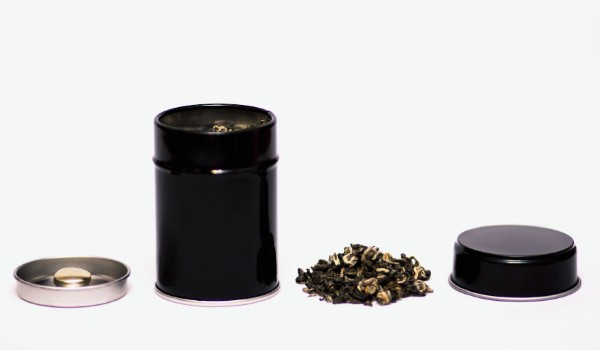To keep green tea fresh and maintain the same delicious flavor as when you first bought it, it must be stored properly.
I’m going to show you how to do it correctly, so you don’t have to drink bland tea all the time.
Key Highlights
- Keep green tea in an airtight container in a cool, dark, and dry place.
- Don’t put an open tea package in the fridge.
- Buy small packs of green tea, finish one, then open the next.
How to Properly Store Green Tea
Green tea should be stored in an airtight, clean container in a cool, dry place away from light, moisture, and heat. The container should fit the amount of tea and be opened only when you need to make tea to lessen the exposure to air.
Also, it’s good to label the container with the type of green tea and the date of storage for simple identification and keeping track of its freshness.

Humidity, high temperatures, oxygen, sunlight, and surrounding odor are the five main factors that can spoil the flavor of your green tea while also severely affecting its beneficial compounds.
Let’s take a look at each of these factors and see how to avoid them so your green tea stays fresh for a longer period of time.
1. Humidity
Moisture is the leading cause of green tea’s benefits and flavor loss, since humidity speeds up the oxidation process of tea leaves.
When green tea leaves are exposed to higher humidity, the beneficial compounds (catechins) decrease. Also, the chlorophyll and vitamin C deteriorate. The tea leaves may become soft and lose their shape, which can lead to a loss of aroma and flavor.
The humidity may rise in containers that are often opened or those that contain a lot of air. If your green tea gradually starts to lose its green color and turn brown, humidity is the problem.
To keep your loose-leaf green tea dry and free of moisture, use a small container and use the contents of the container within 1-2 weeks for the freshest results.
2. High temperature
Storing temperature also has a big impact on green tea’s loose-leaf freshness.
Keeping green tea in a place with high temperatures (ex., near the stove) will speed up catechin degradation. The tea leaves may become too dry and brittle, which can have a negative effect on the flavor and aroma.
The best temperature to store green tea to keep it fresh is under 20 °C (68 °F) away from heat sources or sunlight in a dry, dark place.
If you live in a hot climate and don’t have a cool place to store your tea, you can store it in a refrigerator. If you do this, make sure to take it out of the fridge about an hour or so before using it to avoid condensation and humidity increasing.
3. Oxygen
The oxygen from the air may destroy your green tea if you keep the container open for a longer period of time.
L-theanine, vitamin C, and catechins are especially prone to oxidation.
When the tea compounds in green tea oxidize, the tea liquor turns darker. This is a sign that you’re not keeping the tea leaves properly; they come into contact with air frequently.
You cannot entirely stop the oxidation. There will always be some air between the leaves and at the top of the container.
To reduce the oxidation effect, use a small container with the lid tightly closed. Use the tea within 1-2 weeks.
4. Sunlight
Loose-leaf green tea exposed to sunlight for a prolonged period of time will start changing its green color to a reddish brown. Additionally, the leaves lose their freshness and surface sheen.
The reason for this is the changes that occur in tea compounds under the UV rays of the sun; especially sensitive is chlorophyll, which gives the tea leaves their green color.
Also, exposure to artificial light should be avoided. This is why it’s not recommended to keep your green tea in a glass jar or a transparent plastic bag.
Always use an opaque container and keep it in a dark place to protect the tea from light exposure.
5. Surrounding odor
The odor of the environment, or “ambient scent,” has a significant impact on the flavor and aroma of green tea leaves. This means you should be very cautious about not just where you store your tea, but also what you store it in.
Green tea may quickly absorb the odor of plastic containers or tins with strong-smelling rubber seals. If there are any strongly scented foods nearby, the tea leaves will absorb those smells too.
So it is best to store your green tea in a clean container, smell-free and away from other teas and smelly foods.
Storing Green Tea Packages: Unopened vs. Opened
Unopened packages of green tea that you don’t plan to use right away should be stored in a refrigerator. Opened packages should be kept in an airtight container in a cool, dry, and dark place.
Unopened green tea packages
It’s best to store green tea in the refrigerator as-is, unopened, when you buy it and don’t intend to use it for a while.
When you’re ready to use the tea, take it from the fridge and set it aside to warm to room temperature for 1 hour or longer, depending on your room temperature. This will prevent air moisture from condensing on the tea leaves.
Don’t put the green tea back in the fridge once you’ve opened it.
Opened green tea packages
After you open the package of tea, it is best to put the tea leaves in an opaque and tightly sealed container. Keep the container in a dark, cool place – not in the fridge.
Avoid storing the tea container for everyday use in the fridge. This is because you’ll have to keep it at room temperature every time you take it out of the fridge to avoid condensation.
If you don’t have a proper tea tin, you can use any other vessel that can be sealed airtight, clean, and odor-free. Also, use the appropriate size for the amount of tea (to avoid excess air).
The Shelf Life of Stored Green Tea
Properly stored green tea in an airtight container can stay fresh for about 6–12 months. Keeping it in the fridge before opening will extend its shelf life.
Once you open the package or container, use the tea within a few weeks or months.
Your properly stored green tea may be used within a year, but as you continue to open the container, the tea’s leaves will come into contact with more air. As a result, your tea won’t spoil, but it will start to lose flavor and freshness.
The best practice is to buy tea in small packages and finish one before opening the next.
The Best Method for Storing Excess Green Tea
When you buy more tea than you can drink, simply place it in a container and fill it all the way to the top. Place the container inside a resealable plastic bag or vacuum bag. Remove most of the air. Then put it in the fridge and don’t open it until you need it.
I recommend putting the container in a resealable plastic bag. Putting just the tea leaves in a plastic bag may cause the leaves to crash when you try to remove the air.
Remember to take the tea out of the fridge for at least an hour or more before using it to allow it to adjust to the much warmer environment and avoid condensation.
How to Recognize Expired Green Tea
Expired green tea typically has a moist, dank smell, and some of the leaves look moldy. The main cause of this is improper storage, and you should discard this tea.
There is a big difference between expired and old green tea.
Over time, old green tea may have lost its fresh flavor and look. It usually doesn’t taste good, and the liquid color may be reddish or brown when brewed.
If your tea leaves smell and look fresh, but your brew has a darker color, your tea is not old; you are not brewing it properly.
Here’s a more detailed explanation of why your green tea turns brown after brewing.
Use old green tea leaves for:
- Composting: Tea leaves add a nitrogen-rich component to the composting soil.
- Elimination of unpleasant smells: This works wonders on a stinky fridge. Put the dry leaves in an open container in a smelly place to eliminate odor.
- Making Hojicha: By roasting old green tea leaves, you can transform them into Hojicha tea.
FAQ
Is it OK to freeze green tea?
Yes, you can freeze loose-leaf green tea, but only an unopened package. After you open it, don’t freeze it since the moisture in the leaves crystalizes and damages the structure of the leaf cells, resulting in a change of taste and reduced aroma.
How do I know if green tea is still good?
Green tea is still good for consumption if there are no changes in the color of the leaves, the smell is grassy, light, and fresh, and the leaves are smooth to the touch, dry, whole, and firm.
Can I store green tea in a glass jar?
Yes, you can store green tea in a glass jar as long as you keep the jar away from light, such as in a cabinet.
How long can loose-leaf green tea be stored in paper bags?
Paper bags are not meant for the long-term storage of loose-leaf green tea. If you bought green tea in a paper bag, place it in an airtight container as soon as possible.
Can I store green tea in a plastic container?
No, it’s not recommended to store green or any other type of tea in a plastic container. Plastic isn’t the best odor blocker. Through the plastic, the tea leaves may absorb odors.
How should I store tea bags for a long time?
Tea bags should be stored in the same manner as loose-leaf tea: in an airtight container in a cool, dark, and dry environment.
The Takeaway
When it comes to green tea storage at home, it’s important to remember:
- Always buy high-quality loose-leaf green tea. Keep it away from light in a cool, dry place in a small, airtight container.
- Unopened packs of tea can be stored in a fridge. Before opening, leave the pack at room temperature for a couple of hours to avoid condensation. After opening the pack, never put it back in the fridge.
- To make sure that you always get a flavorful cup of tea, use the tea from the stored container within a few weeks.
By following these tips, you’ll be able to keep your green tea as fresh as the first time you opened the bag and always have a flavorful cup of tea.

